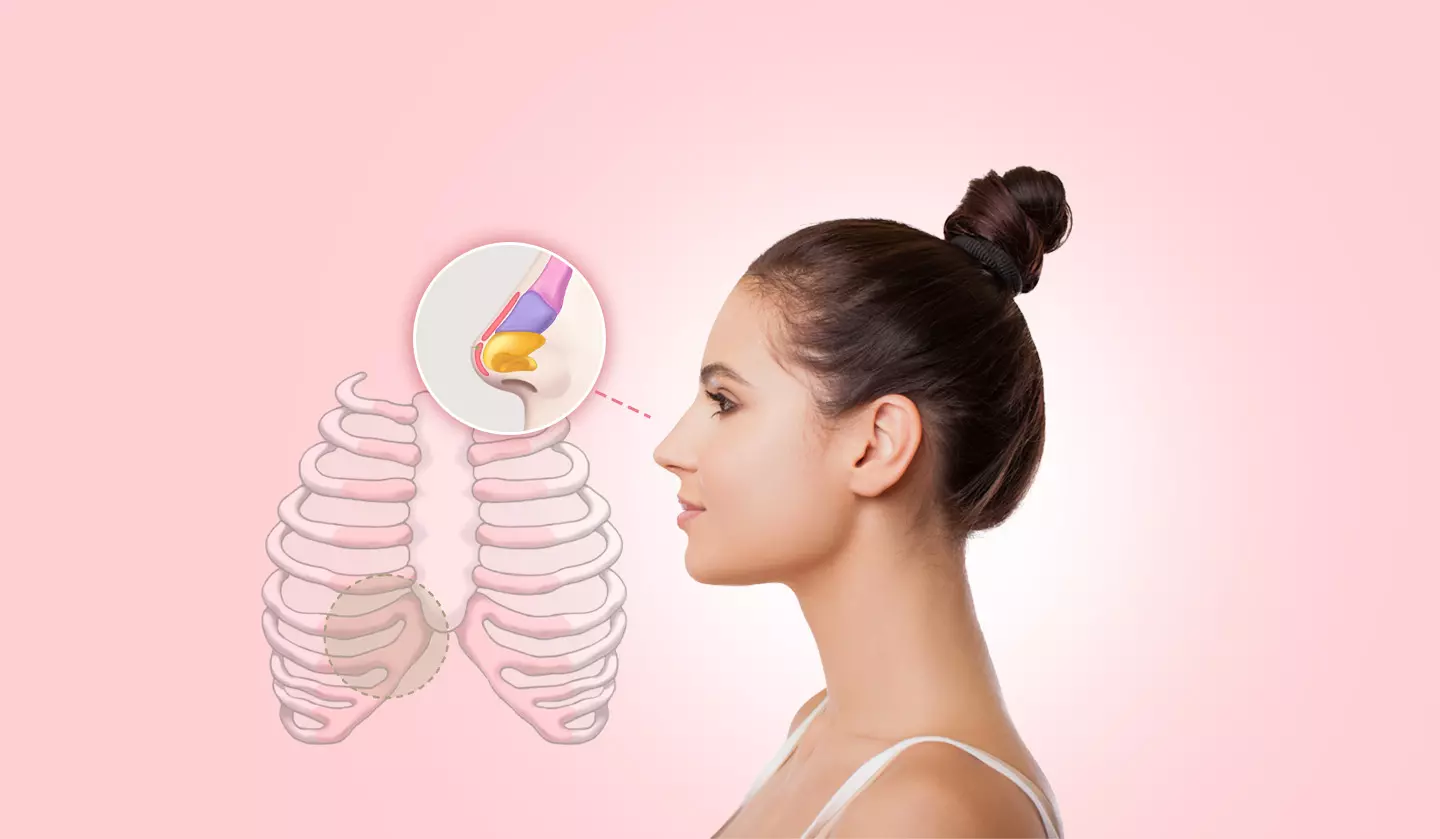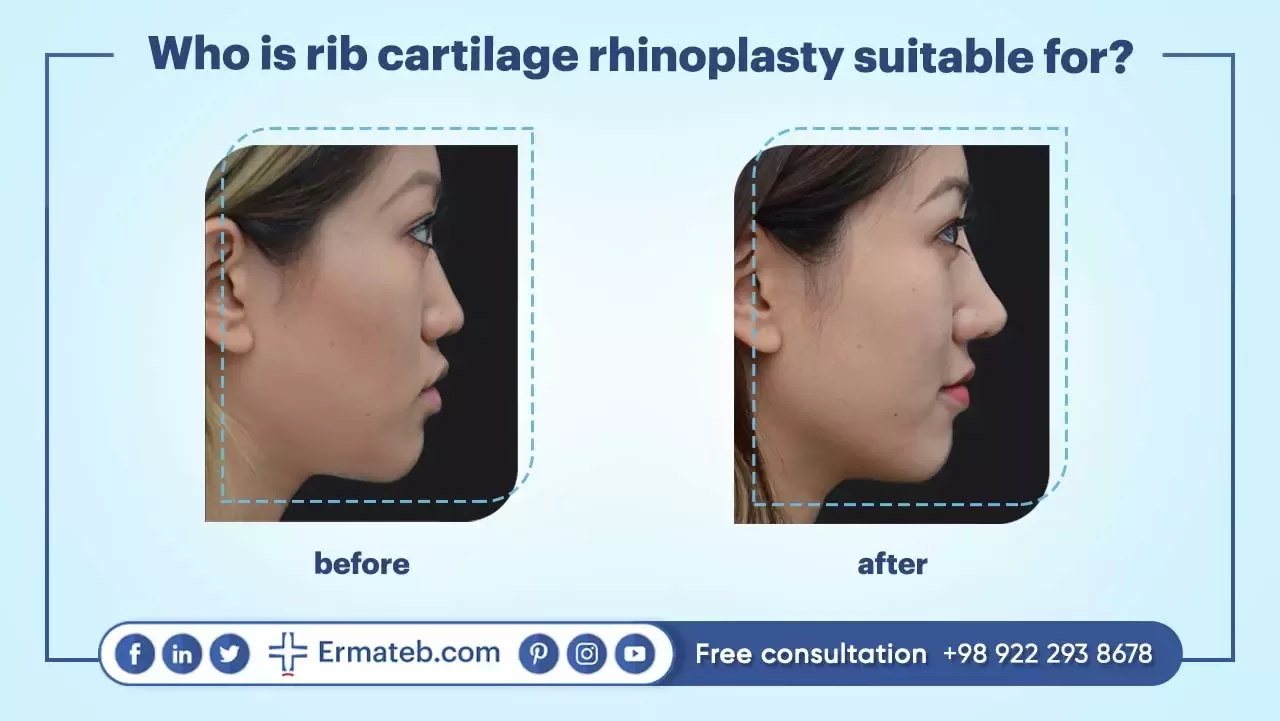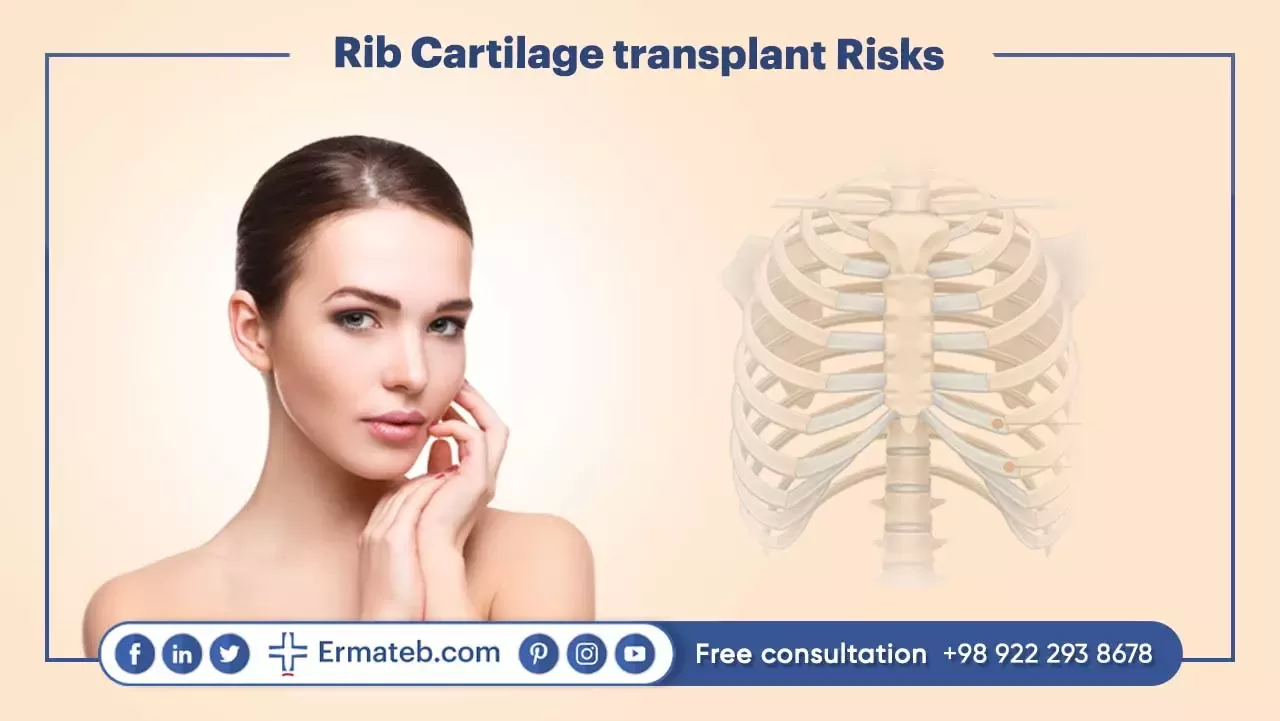
If you’re considering rhinoplasty or revision rhinoplasty, rib cartilage emerges as a durable and versatile graft material for both functional and aesthetic nose reconstruction. This premium technique, demands a surgeon’s deep understanding due to the complexity of revising altered nasal structures from prior surgeries.
Among rhinoplasty techniques, rib cartilage rhinoplasty stands out for its unique utilization of the patient’s rib cartilage. This method offers distinct benefits, risks, and a tailored recovery process, providing a nuanced approach compared to other rhinoplasty methods.
Rib cartilage rhinoplasty, whether using %100 natural rib cartilage or a combination with silicone implants, underscores its versatility. Originally reserved for serve short noses and infections, rib cartilage rhinoplasty now seeks facial harmony and balance, correcting not just nasal dimensions but also enhancing overall facial aesthetics. For those considering revision rhinoplasty without external implants, rib graft proves to be a fitting and natural choice, provided the procedure is entrusted to a skilled practitioner.

Rib cartilage rhinoplasty emerges as an adaptable solution catering to a diverse range of patients with specific aesthetic and functional objectives for their noses. This transformative procedure addresses various concerns, making it suitable for individuals facing distinctive nasal challenges.
Delve into the diverse costs of rib cartilage graft rhinoplasty worldwide, with expenses varying significantly. In the USA, primary procedures commence at $15,600, while revisions start at $16,000, potentially escalating for intricate cases, reaching up to $26,000, especially if cartilage grafts are required. In Turkey, the initial cost is approximately $2,000, but Iran emerges as the ideal destination, offering a budget-friendly range of $1,500 to $2,500 ( Revision rhinoplasty in Iran ). Iran not only provides affordability but also boasts a stellar reputation for medical expertise and top-notch facilities, particularly in rhinoplasty and revision rhinoplasty procedures. Choosing Iran ensures access to skilled professionals, high-quality healthcare, and transparency about additional costs for necessary cartilage grafts.
Ideal for individuals experiencing nasal congestion due to infection or multiple surgeries, rib cartilage rhinoplasty offers a path to improved nasal function.
Tailored for those with a protruding mouth or a receding middle face, this procedure aims to achieve facial harmony and balance.
Perfect for individuals with flat, short, or upturned noses, rib cartilage rhinoplasty can redefine and aesthetically enhance the nose, complementing overall facial features.
Suited for individuals with noses altered by the injection of foreign objects, providing corrective solutions for a natural-looking result.
Beneficial for individuals with cleft lip nose deformity or those with damaged noses due to accidents or extensive surgeries, offering reconstruction and restoration of function and appearance.
Suitable for individuals with a thin layer of muscle on the nose, this procedure achieves a very prominent nose where other materials like silicone may not be viable, ensuring a natural-looking and enduring result.

Cartilage grafts play a crucial role in rhinoplasty procedures, offering the necessary material to shape and support the nose. While cartilage can be sourced from various areas such as the nasal septum, ear, or rib, septal cartilage is often considered the “ideal” choice due to its strength and thin composition. However, the challenge arises when septal cartilage is absent or removed during prior rhinoplasty procedures, necessitating the use of grafting material for revisions.
In the absence of septal cartilage, surgeons typically turn to alternative sources, namely the ear or rib. Ear cartilage becomes a valuable option, particularly in specific locations and for targeted concerns during revision rhinoplasty. Surgeons may strategically choose ear cartilage when addressing particular areas within the nose, ensuring optimal results in specific contexts and for defined purposes.
Opting for rib cartilage graft in rhinoplasty comes with distinct advantages, yet certain considerations warrant attention. Let’s delve into the crucial aspects to ensure informed decisions:
Harvesting rib cartilage may introduce some discomfort and swelling in the chest region, extending the recovery duration compared to alternative graft materials. Prospective patients should be prepared for a longer healing process.
The intricacies of rib cartilage harvesting demand specialized surgical skills and experience. It is paramount to select a qualified plastic surgeon well-versed in this technique. Prioritize expertise to ensure a successful and satisfactory rhinoplasty outcome.
The use of rib cartilage necessitates an extra incision on the chest. Although this may result in a visible scar, the incision is typically minimal and strategically placed within the natural creases of the chest.
Rib cartilage rhinoplasty is a surgical procedure designed to reshape the nose using harvested rib cartilage, this intricate process involves several key steps to ensure a successful and aesthetically pleasing outcome.
The journey begins with the administration of general anesthesia to the patient. This crucial step ensures the patient’s comfort and a pain-free experience throughout the procedure.
A small incision is strategically made on the patient’s chest, typically on the 6th or 7th rib. Through this incision, a piece of rib cartilage, approximately 5cm in length, is delicately extracted. The incision usually results in a 4-5cm wound on the chest. The harvested rib cartilage is then meticulously contoured to achieve the desired shape for the patient’s nose.
An incision on the nose is performed using an open technique, commonly on the columella—the strip of tissue that separates the nostrils. This precise incision allows the surgeon access to the underlying septal cartilage and bone.
The contoured rib cartilage is skillfully positioned on the patient’s septal cartilage, and adjustments are made to attain the desired nasal shape. This step is crucial for achieving the patient’s aesthetic goals and ensuring a harmonious result.
With the rib cartilage in place, the incision on the nose is meticulously closed using sutures. Simultaneously, the chest wound is closed with either staples or sutures. This careful closure is essential for optimal healing and minimizing visible scarring.
It’s imperative to emphasize that rib cartilage rhinoplasty is specifically tailored for individuals with minimal muscle around the nose bridge, aiming to achieve a distinctly prominent nose. Moreover, this procedure can be seamlessly combined with other techniques such as tip refinement, nostril reduction, and septoplasty to address a variety of aesthetic concerns.
Following your rhinoplasty procedure, a period of postoperative care is crucial for a smooth recovery. Here are key considerations:
In the initial days after surgery, gauze packing may be used to provide support to the nose during the healing process.
While post-surgery swelling subsides within a few weeks, the complete development of your new nose shape may take up to a year. Gradual improvements in the nose’s appearance will be noticeable during this transformative period.
It’s normal for swelling to reappear and potentially intensify in the morning during the first year following surgery.
Your surgeon or nurse will provide specific instructions, covering:
Initiate the process by contacting us for a no-cost virtual consultation. Our experienced virtual consultants and surgeons will offer personalized recommendations tailored to your unique needs. Recognizing the individuality of each client, we customize procedures to achieve optimal results.
Embarking on rib cartilage rhinoplasty introduces a multitude of benefits and disadvantages for patients seeking optimal nasal reshaping. These include:
Advantages:
Rib graft rhinoplasty, using rib cartilage, delivers long-lasting results, as the strong cartilage can withstand daily life forces.
The strength of rib cartilage allows precise shaping and molding, creating a more defined and aesthetically pleasing nose.
Rib Cartilage yields a nose with a natural appearance and feel, closely mimicking native nasal cartilage characteristics.
Particularly beneficial for patients with a thin layer of muscle around the nose, aiming for a prominent nose, or those requiring nose reconstruction due to injury, trauma, or congenital defects.
Utilizing rib cartilage reduces the risk of rejection or adverse reactions, as it is naturally compatible with the patient’s body.
Renowned for strength and resilience, rib cartilage provides enduring outcomes, capable of withstanding the test of time.
Rib cartilage rhinoplasty achieves the highest nose bridge, contributing to a prominent and aesthetically pleasing nose shape.
Rib cartilage stands out for its adaptability, allowing surgeons to shape and customize it for diverse nasal reshaping techniques.
Harvesting rib cartilage from the patient’s own body eliminates the risk of rejection or allergic reactions.
Disadvantages:
Extraction of rib cartilage requires the administration of general anesthesia. While it ensures patient comfort during the procedure, it also brings an elevated risk of complications and may not be suitable for certain individuals.
The process involves two incisions—one to extract the rib cartilage and another to reshape the nose. This may result in an extended recovery period and a heightened risk of scarring.
Extraction of rib cartilage requires the administration of general anesthesia. While it ensures patient comfort during the procedure, it also brings an elevated risk of complications and may not be suitable for certain individuals.
While rib cartilage presents a viable option for rhinoplasty, there are inherent risks associated with the procedure that require careful consideration.
Even in experiences hands, rib cartilage may undergo warping or changes in shape, impacting the nose’s appearance.
It is crucial to engage in thorough discussions with the surgeon the understand these risks and establish realistic expectations before proceeding with rhinoplasty.
Addressing concerns about scarring near the ribs is a common consideration in rib cartilage rhinoplasty. But there is no need to be worried, because the skilled and professional surgeons employ a specialized technique, ensuring a minimal incision of 2-3cm during rib cartilage harvesting. The incision strategically follows the line underneath the breast, resulting in nearly invisible scarring. Dedicated post-care further contributes to the gradual fading of the incision line over time.
According to “autologous rib cartilage, in addressing common nasal characteristics among Asians, like a short and depressed nose, retruded columella, and mid-face retrusion, the use of autologous cartilages becomes essential. The typical challenged associated with implant materials, such as infection, silicone displacement, extrusion, and skin thinning, prompt the preferences for autologous options in Asian rhinoplasty.
While septal and ear cartilage may be insufficient or less sturdy for certain cases, rib cartilage emerges as a highly advantageous material. The unique characteristics of rib cartilage, including its ample quantity, robust structural support, and autologous nature, make it the material of choice for procedures targeting nasal elongation, tip projection, and augmentation of dorsum and mid-face in Asian noses. Rib cartilage not only provides the required structural support but also ensures safety through its autologous origin, making it a reliable option for cases involving short noses, damaged noses, infections, and mid-face retrusion.
In rhinoplasty procedures, the utilization of donor cartilage, specifically from the rib, presents notable advantages. A key benefit is the significant time savings achieved during the surgery. Prepared in advance for the surgeon, donor rib cartilage can be swiftly transplanted to new areas of the nose, enhancing precision in crafting the desired shape and expediting overall results.
This streamlined process contrasts with the alternative of harvesting all cartilage from the patient's own body, allowing for a more efficient and time-effective surgical approach. Beyond time considerations, donor rib cartilage brings inherent strength, surpassing other cartilage types. This strength not only contributes to the durability of the rhinoplasty outcome but also offers enhanced support and stability to the nose, reinforcing the overall success of the procedure.
In answer to this question, it can be said that every surgery has its own side effects, but considering the new methods and the large number of this surgery, as well as the post-operative care that is done, it can be said that rib cartilage rhinoplasty is safe and this surgery is not dangeoruos.

While the utilization of donor rib cartilage in rhinoplasty brings potential benefits, it is essential to acknowledge and address associated risks. A primary concern is the risk of rejection, as the body may perceive donor tissue as foreign, leading to complications. To mitigate this risk, surgeons must meticulously select high-quality donor cartilage from reputable sources, adhering to stringent sterilization protocols. This diligence is crucial to reduce the likelihood of rejection and enhance the overall success of Miami rhinoplasty revisions.
Patients opting for this approach should be aware that the surgery entails a heightened risk compared to traditional techniques. Any alterations in the rib cartilage’s shape could potentially manifest visible changes in nasal appearance. Additionally, there are long-term complications associated with commercially available donated rib cartilage. While it spares patients from the extraction process, it poses challenges as a non-autologous material.
In a nutshell, potential complications include:
1.High risk of infection, posing challenges in treatment and risking damage to nasal soft tissues.
2.Increased cartilage absorption over time, approaching nearly %100 after several years.
3.Limited capacity for detailed structure creation due to the inherent weakness of the tissue.
4.Proneness to breakage due to reduced elasticity.
5.Formation of capsules around the foreign material, leading to complications.
6.Transmission of diseases such as hepatitis, HIV, or Creutzfeldt-Jakob disease, rendering cadaver rib cartilage illegal in some countries for medical and cosmetic operations.
Opting for a patient’s own cartilage in rhinoplasty yields enduring results, a notable advantage compared to artificial implants that may present long-term issues. Beyond rib cartilage, the reconstruction of the nose can involve harvesting cartilage from alternative areas of the body:
Septal cartilage, characterized by its straight and firm structure, is an optimal choice that eliminates the need for external harvesting. However, its availability may be limited, especially in revision rhinoplasty scenarios where prior septal cartilage removal might have occurred.
The flexibility and strength of ear cartilage make it an ideal choice for rhinoplasty procedures. Opting for ear cartilage rhinoplasty significantly reduces the risk of warping. Notably, extracting a substantial amount of cartilage from the ear does not lead to noticeable changes in its appearance.
The selection of cartilage source depends on the individual case, with each option offering unique advantages and considerations in achieving desired rhinoplasty outcomes.
When considering materials for rhinoplasty, rib cartilage stands out as a superior choice for several reasons:
Incisions made underneath the breast line result in minimal scarring, enhancing the aesthetic appeal.
Unlike septal or ear cartilage, rib cartilage is plentiful, allowing for greater flexibility in designing the nose.
Rib cartilage is resistant to infections, promoting a safer and more reliable surgical experience.
Rib cartilage is a natural tissue, ensuring compatibility and reducing the risk of complications.
The use of rib cartilage provides lasting results, contributing to the longevity of the rhinoplasty outcome.
Over time, rib cartilage incorporates into the body, creating a nose structure that feels innate and harmonious.
Compared to cadaver rib cartilage, rib cartilage exhibits minimal absorption over time.

It is normal to be concerned about scarring from the incision line resulting from rib cartilage removal. However, plastic surgery makes minimal incisions (2-3 cm) with a special technique to solve this problem. The cut line is followed along the line below the bust line and thus the line becomes almost invisible. If the incision line is taken care of with proper aftercare, the incision line will eventually fade over time.
When contemplating rhinoplasty, consulting with a proficient plastic surgeon is crucial. At Ermateb, we offer expert guidance and tailored care to address your specific needs. Reach out to our medical facility today to schedule a consultation and explore the ways rib cartilage can elevate and refine your rhinoplasty results.
For professional information you can read this article in Pubmed

